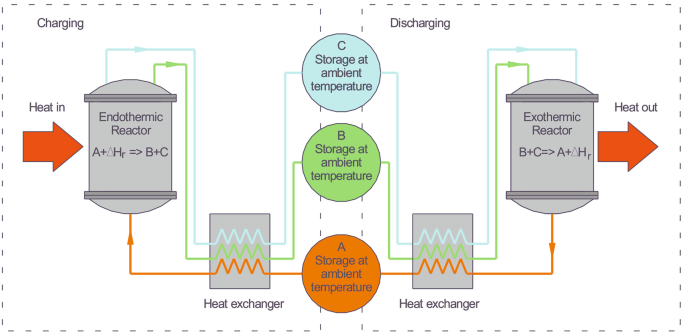Thermochemical Energy Storage System
Contact us today for the perfect temperature control solution
The energy problem is one of the problems facing the world today, which is mainly manifested in the imbalance of energy supply, insufficient supply, and unsustainable consumption patterns. Traditional fossil fuels have played a huge role in the development of human society, but their use has also brought serious problems to the environment, such as the greenhouse effect, acid rain, etc. Therefore, in order to gradually realize the utilization of sustainable energy and reduce environmental pollution, people are studying new energy storage technologies. This article will elaborate from the perspective of thermochemical energy storage system, aiming to understand the characteristics and advantages of thermochemical energy storage system.
1. Overview of Thermochemical Energy Storage System
Thermochemical energy storage refers to the process of converting chemical energy into thermal energy and converting it back into chemical energy when thermal energy is needed. The technology mainly consists of three components: thermochemical storage, thermochemical generator and thermochemical cooling source. Thermochemical storage materials convert chemical energy into heat energy through endothermic reactions and store it, thermochemical generators use heat energy to generate electricity, and thermochemical cold sources release heat energy to achieve air conditioning and refrigeration functions.

2. Thermochemical energy storage mainly has the following advantages:
(1) High energy density. Compared with other energy storage technologies, thermochemical energy storage has higher energy density and can store more energy in the same volume.
(2) Good controllability. In a thermochemical energy storage system, the thermal energy conversion of thermochemical storage materials can be controlled by external conditions (such as temperature, pressure, etc.), so that energy can be stored and released on demand.
(3) Environmentally friendly. Thermochemical storage materials are mostly organic substances, which cause less pollution to the environment, while thermochemical generators use heat energy to generate electricity, and do not emit waste gas and waste water, so they have less environmental pollution.
3. Thermochemical storage
Thermochemical storage is the most important part of the thermochemical energy storage system, and its main function is to convert chemical energy into thermal energy and store it. The selection of thermochemical storage materials should consider factors such as energy density, reaction rate, and reaction heat value. At present, the commonly used thermochemical storage materials are as follows:
(1) Resorcinol. Resorcinol is a reversible endothermic reaction reservoir whose chemical reactions are related to temperature changes. It has strong heat absorption and heat release capabilities, and realizes high efficiency of energy storage and thermal energy conversion.
(2) Calcium chloride hydrate. Calcium chloride hydrate can store a large amount of heat energy in the form of reaction endotherm at a low temperature below -10C. Its reaction rate is fast, but its energy storage density is low.
(3) Amino acid salts. Amino acid salt is a new type of energy storage material. Its reaction releases a large amount of heat and has a strong heat absorption capacity. The product after the reaction is easy to recycle and reuse.
4. Thermochemical generators
A thermochemical generator is a device that converts stored thermal energy into electrical energy in a thermochemical energy storage system. Its working principle is to convert thermal energy into electrical energy, and use fuel cells, thermoelectric equipment, etc. to convert chemical energy into electrical energy.
A fuel cell is an electrochemical device that converts hydrogen and a gaseous oxidant such as air into electrical and thermal energy in the form of a chemical reaction. Its biggest advantage is that it can generate zero-polluting electricity, and can use fuel directly without converting it into electricity first. At present, more mature fuel cells include proton exchange membrane fuel cells and solid oxide fuel cells.
A thermoelectric device is an electronic device that converts thermal energy into electrical energy. Its working principle is to use the thermoelectric effect generated by the material under the temperature gradient to convert thermal energy into electrical energy. The thermochemical energy storage system converts the stored thermal energy into electrical energy through a thermochemical generator, which can realize flexible energy storage and use, and is a very promising energy storage technology.
5. Thermochemical cold source
The thermochemical cold source in the thermochemical energy storage system mainly refers to the equipment that uses the stored heat energy to realize the functions of air conditioning and refrigeration. Compared with traditional air-conditioning refrigeration technology, thermochemical cold source has the advantages of environmental friendliness, low noise and long service life, so it has been more and more widely used in modern buildings, urban cold and heat supply and other fields.
Thermochemical air-conditioning and refrigeration technologies mainly include the following types:
(1) Adsorption air conditioning refrigeration technology. This technology uses the adsorption effect of the adsorbent to absorb moisture in the air at low temperature, and then release the moisture at high temperature to produce a cooling effect. It has the advantages of stable operation, no noise, and low energy consumption.
(2) Refrigerated cabin technology. The technology uses thermochemical storage for cooling, which can store thermal energy outside of summer and then use this thermal energy for cooling, reducing environmental impact and greatly reducing cooling costs.
Summarize
With the increasing global energy demand and the instability of energy supply, thermochemical energy storage technology, as a promising energy storage technology, has high application potential. From the thermochemical energy storage system, we can see that it has the advantages of high energy density, good controllability, and environmental friendliness, and it is gradually moving towards commercial application. However, there are still some problems in thermochemical energy storage technology. Such as storage efficiency, reaction rate, cost, etc., need to be solved through continuous technological innovation. It is expected that with the development of technology, thermochemical energy storage technology will be more widely used in the future. application.
Email: info@lneya.com WeChat ID: +8615251628237 WhatsApp: +86 17851209193
 LNEYA
LNEYA
 简体中文
简体中文


















































































